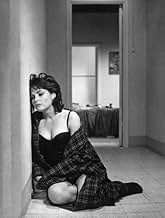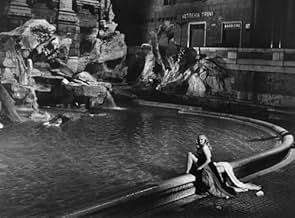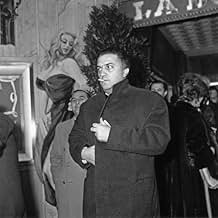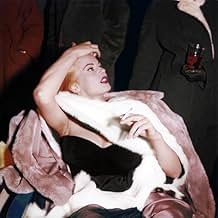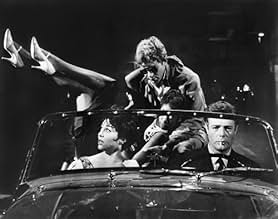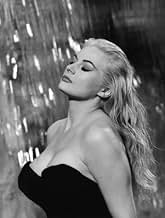Uma série de histórias que se seguem por uma semana, a vida de um jornalista que mora em Roma.Uma série de histórias que se seguem por uma semana, a vida de um jornalista que mora em Roma.Uma série de histórias que se seguem por uma semana, a vida de um jornalista que mora em Roma.
- Direção
- Roteiristas
- Artistas
- Ganhou 1 Oscar
- 11 vitórias e 12 indicações no total
Anouk Aimée
- Maddalena
- (as Anouk Aimee)
Magali Noël
- Fanny
- (as Magali Noel)
Resumo
Reviewers say 'La Dolce Vita' delves into themes of fame, decadence, and the superficiality of celebrity culture, using these characters to underscore the contrasts and contradictions within high society. The portrayal of it's characters enhances the film's satirical and critical perspective on the lifestyles and attitudes of the era, offering a nuanced commentary on the nature of fame and its impact on individuals and society.
Avaliações em destaque
When it comes to art, the best one can do is receive it with grace, measure it against one's soul and if one is so inclined, speak from the heart about it. That's the only thing that matters, all else falling away. Comments about the execution are irrelevant, really. If someone talks about that, it isn't from their heart and doesn't really matter. This is excellently executed, but with art the only demand is that it cross a threshold of competence, making it close enough for us to reach. All else is decoration. Read elsewhere for comments on the decorative qualities of this.
I'll start from the end. I recommend you see this because it is a necessary launching ramp for "8 1/2." I believe that film is essential viewing for any citizen of the world, and to get it, you have to sit through this. Its roughly the same shape: Fellini himself, an empty and artless man posing as an artist who can only place himself in a definition of emptiness defined by the seven types of women.
In this world a convincing one women define the world by their being, and all spaces physical spaces I mean are carried by them into existence. Men merely stand between surrounding walls and the woman who made them whether she is present or not. When strained through the cloth of cinema, we have something like this film. (I wish some Japanese filmmaker would do for this what "H Story" did to "Hiroshima Mon Amore" but in Barcelona.)
So it is a competent film, even decorative. It is art, and for reasons beyond itself, you should see it.
But it doesn't measure well against my soul. Nor famously did it against Fellini's, which is why, after a celebrated crisis, he developed a different style for his next films. I suppose it is true that you could see this as about the bankruptcy of Roman aristocrats, or about more general bankruptcy of men. But I see it as about Fellini's own self inflicted, selfaware malaise.
But why is this one recommended to be rejected and the later one valued? Because of the cinematic form, dear friends. That's all that matters. Usually this form is considered realistic or neorealistic and the later films fantastic surreal. I think we can do better than that. The "neorealistic" films are composed by a self that stands outside. It sees and reports. It sees and judges; this is a film that assumes judgment. Its an essay, "explained" because both the filmmaker and the viewer stand outside it. Even the edges of the frame are perfectly placed, so as to remind us of the window we peer through.
"8 1/2" and his other project I admire ("Block-notes di un regista") have the filmmaker distinctly in the thing. The edges shift. We are invited in. Some things aren't clear, what we encounter hasn't been filtered to make sense for us. Its a party, but not one the camera understands, so we are in the midst of the battle instead of observing the party.
So if it is art you come for, you won't find it here unless you think competent decoration and impressive effect matter. What matters is whether the artist's blood mingles with ours, and Fellini didn't bleed until after this, probably because of this. Later, he did add that girl at the beach so his types of women total 8. I suppose you need to see this, then "8 1/2," then Greenaway's "8 1/2 Women."
It may not be the best way to capture a film, by bracketing it somehow. But it works for me in this case. This is just a bracket.
+++++++
One could say things about many of the characters and performances, and I cannot resist mentioning one: Nico. In the next to last segment, she plays a top model engaged to a royal nitwit. We gather at his castle and go ghost-hunting where we are given the woman-outside- the-walls story. This was when she really was a top model and before she became Andy Warhol's primary avatar in the world. She originated the "Gothic" look copied by millions of girl misfits. She reinvented a form of sultry singing (then newly in rock) that turns the notion of this movie inside out: deliberately soulless and therefore attractive.
This film also brackets her amazing glow as the Chelsea Girl. THE Chelsea Girl.
You should know about her. She had a real life. We all live in the ashes, unbeknownst.
Ted's Evaluation -- 3 of 3: Worth watching.
I'll start from the end. I recommend you see this because it is a necessary launching ramp for "8 1/2." I believe that film is essential viewing for any citizen of the world, and to get it, you have to sit through this. Its roughly the same shape: Fellini himself, an empty and artless man posing as an artist who can only place himself in a definition of emptiness defined by the seven types of women.
In this world a convincing one women define the world by their being, and all spaces physical spaces I mean are carried by them into existence. Men merely stand between surrounding walls and the woman who made them whether she is present or not. When strained through the cloth of cinema, we have something like this film. (I wish some Japanese filmmaker would do for this what "H Story" did to "Hiroshima Mon Amore" but in Barcelona.)
So it is a competent film, even decorative. It is art, and for reasons beyond itself, you should see it.
But it doesn't measure well against my soul. Nor famously did it against Fellini's, which is why, after a celebrated crisis, he developed a different style for his next films. I suppose it is true that you could see this as about the bankruptcy of Roman aristocrats, or about more general bankruptcy of men. But I see it as about Fellini's own self inflicted, selfaware malaise.
But why is this one recommended to be rejected and the later one valued? Because of the cinematic form, dear friends. That's all that matters. Usually this form is considered realistic or neorealistic and the later films fantastic surreal. I think we can do better than that. The "neorealistic" films are composed by a self that stands outside. It sees and reports. It sees and judges; this is a film that assumes judgment. Its an essay, "explained" because both the filmmaker and the viewer stand outside it. Even the edges of the frame are perfectly placed, so as to remind us of the window we peer through.
"8 1/2" and his other project I admire ("Block-notes di un regista") have the filmmaker distinctly in the thing. The edges shift. We are invited in. Some things aren't clear, what we encounter hasn't been filtered to make sense for us. Its a party, but not one the camera understands, so we are in the midst of the battle instead of observing the party.
So if it is art you come for, you won't find it here unless you think competent decoration and impressive effect matter. What matters is whether the artist's blood mingles with ours, and Fellini didn't bleed until after this, probably because of this. Later, he did add that girl at the beach so his types of women total 8. I suppose you need to see this, then "8 1/2," then Greenaway's "8 1/2 Women."
It may not be the best way to capture a film, by bracketing it somehow. But it works for me in this case. This is just a bracket.
+++++++
One could say things about many of the characters and performances, and I cannot resist mentioning one: Nico. In the next to last segment, she plays a top model engaged to a royal nitwit. We gather at his castle and go ghost-hunting where we are given the woman-outside- the-walls story. This was when she really was a top model and before she became Andy Warhol's primary avatar in the world. She originated the "Gothic" look copied by millions of girl misfits. She reinvented a form of sultry singing (then newly in rock) that turns the notion of this movie inside out: deliberately soulless and therefore attractive.
This film also brackets her amazing glow as the Chelsea Girl. THE Chelsea Girl.
You should know about her. She had a real life. We all live in the ashes, unbeknownst.
Ted's Evaluation -- 3 of 3: Worth watching.
I just saw a new print of this wonderful film after not having seen it for maybe 20 years and it is still spellbinding. Fellini sums up an era and an attitude here, and succeeds in doing something that ought to be impossible: he makes a full and meaningful film about empty and meaningless lives. Mastroianni seems to have been to Fellini what DeNiro has been to Scorsese--a perfect embodiment of a personal vision. What a wonderful actor he was--brilliant in his youth and in his age. Many other performers are hardly less fine here, and the cinematography and composition are stunning throughout. There are so many indelible images from this film, images that have become iconic over the decades: Ekberg in the Fontana di Trevi, the statue of Christ flying over Rome, the astonishing, candlelit procession at the castle, to name a few. It seems plot less and yet it isn't plot less at all; Marcello's ultimately fruitless search for meaning, a search that he abandons in the end, as he stares across a slight and yet unbridgable abyss on the beach at a lovely young girl who seems to possess the knowledge and understanding that is denied to him. I'm astonished at the number of people who don't get this movie, who seem to think that Fellini expects us to admire the bizarre characters who people the film, or who think that a movie about worthless individuals must be a worthless movie, or who don't seem to understand that movies that are full of what become clichés usually do so because they capture an important vision. Fellini made several exceptional films: 81/2, La Strada, Amarcord, and The Nights of Cabiria come to mind, but La Dolce Vita may be, when all is said and done, his masterwork.
There really isnt a plot. This is about a tabloid photographer and some scenarios he gets into. All the characters seem vain, selfish and wanting more from life without actually knowing what they want. The Rome nightlife is brought to life here and there are many scenes at lavish parties where all the characters dont appear to have any emotional connection to one another. There are also disconnected Catholic themes throughout the movie. It leaves you questioning your own life and emptiness.
Marcello Rubini (Marcello Mastroianni) is a man-about-town and a gossip journalist in Rome. His girlfriend Emma overdoses and recovers. Swedish-American bombshell Sylvia (Anita Ekberg) arrives and hangs out with Marcello while the Paparazzo hounds them. Her boyfriend Robert gets angry and hits him. As his series of adventures continue, there is an emptiness to it all and a meaninglessness to his life.
This iconic film has a disjointed narrative structure. It has many sections without the connective tissue. It's a tough watch especially for a three hour movie. It's exhilarating for a long time but it gets tiring by the end. The sad emptiness infects the viewing experience. The lifestyle is thoroughly modern celebrity world. The thrill disapates. Its iconic nature deserves extra points, but this is strictly for film fans.
This iconic film has a disjointed narrative structure. It has many sections without the connective tissue. It's a tough watch especially for a three hour movie. It's exhilarating for a long time but it gets tiring by the end. The sad emptiness infects the viewing experience. The lifestyle is thoroughly modern celebrity world. The thrill disapates. Its iconic nature deserves extra points, but this is strictly for film fans.
Long, episodic film by Federico Fellini about the conceits and facades of life: fame, intellect, sex, friendship, despair, innocence, etc.
Marcello Mastroianni is perfect as the shallow tabloid reporter who joyfully follows around Rome a blonde movie star from Sweden (Anita Ekberg) as she prowls around the city's bars and bistros. He is also having an affair with a woman (Anouk Aimee) while his girl friend (Yvonne Furnaux) seems to be going nuts.
But as Marcello moves through the city following the movie star, the miracle of the virgin, a few parties, etc. we see that his life is very empty because the things he reports on are meaningless drivel. We see that fame and fortune and the trappings of success are meaningless.
Marcello starts to realize that the movie star is a vapid airhead, the miracles are a sham, and his friend's (who seemed quite happily married) ghastly murder and suicide show the futility of life itself.
The Fellini themes are common to many of his films, but what makes La Dolce Vita so memorable are the cynical tone, the Nina Rota music, and the string of terrific visual images.
The opening scene is of a helicopter hauling a gilded plaster statue through the air across Rome. The flying saint is a bizarre image but serves to set up the movies which is all about images and events that are never what they seem to be.
Notable are the scenes of statuesque Ekberg in that terrific strapless black dress with the voluminous skirts as she swishes around dancing and eventually wading through a city fountain. The party scenes are also notable. The first because of the intolerable intellectuals who sits around and talk and talk but never do anything. The last party has the indelible image of Mastroianni "riding" a drunken blonde woman as though she were a horse. The final image of the giant dead fish is quite unsettling as it symbolizes their bloated lives.
Fellini is brilliant in filling scenes with odd people as extras, usually hideously dressed or wearing ugly glasses. The "gallery" of people who inhabit the city is one of grotesques, vapid fashion slaves, the rich, hangers on, etc.
A long film, but highly recommended and very memorable.
Marcello Mastroianni is perfect as the shallow tabloid reporter who joyfully follows around Rome a blonde movie star from Sweden (Anita Ekberg) as she prowls around the city's bars and bistros. He is also having an affair with a woman (Anouk Aimee) while his girl friend (Yvonne Furnaux) seems to be going nuts.
But as Marcello moves through the city following the movie star, the miracle of the virgin, a few parties, etc. we see that his life is very empty because the things he reports on are meaningless drivel. We see that fame and fortune and the trappings of success are meaningless.
Marcello starts to realize that the movie star is a vapid airhead, the miracles are a sham, and his friend's (who seemed quite happily married) ghastly murder and suicide show the futility of life itself.
The Fellini themes are common to many of his films, but what makes La Dolce Vita so memorable are the cynical tone, the Nina Rota music, and the string of terrific visual images.
The opening scene is of a helicopter hauling a gilded plaster statue through the air across Rome. The flying saint is a bizarre image but serves to set up the movies which is all about images and events that are never what they seem to be.
Notable are the scenes of statuesque Ekberg in that terrific strapless black dress with the voluminous skirts as she swishes around dancing and eventually wading through a city fountain. The party scenes are also notable. The first because of the intolerable intellectuals who sits around and talk and talk but never do anything. The last party has the indelible image of Mastroianni "riding" a drunken blonde woman as though she were a horse. The final image of the giant dead fish is quite unsettling as it symbolizes their bloated lives.
Fellini is brilliant in filling scenes with odd people as extras, usually hideously dressed or wearing ugly glasses. The "gallery" of people who inhabit the city is one of grotesques, vapid fashion slaves, the rich, hangers on, etc.
A long film, but highly recommended and very memorable.
Você sabia?
- CuriosidadesThe famous scene in the Trevi Fountain was shot over a week in March, when nights were still cold. According to Federico Fellini (in an interview with Costanzo Costantini), Anita Ekberg stood in the cold water in her dress for hours with no trouble. Marcello Mastroianni, on the other hand, had to wear a wetsuit beneath his clothes, and even that wasn't enough. Still freezing, he downed an entire bottle of vodka, so he was completely drunk while shooting the scene.
- Erros de gravaçãoWhen Marcello and Maddalena arrive at the prostitute's apartment, a long electric cable (light?) can be seen attached to the right rear of the car, moving along until the car stops.
- Versões alternativasIn the original American release, distributed by American International Pictures, the titles open with the AIP logo and appear over a shot of the sky with clouds. In the current release on DVD - and as shown on TCM - the title sequence is over a black background. When originally released, censors in several countries trimmed certain scenes, including the orgy near the end of the film.
- ConexõesEdited into La case du siècle: Cinecittà, de Mussolini à la Dolce Vita (2021)
Principais escolhas
Faça login para avaliar e ver a lista de recomendações personalizadas
Detalhes
- Data de lançamento
- Países de origem
- Central de atendimento oficial
- Idiomas
- Também conhecido como
- La dulce vida
- Locações de filme
- Villa Giustiniani-Odescalchi, Bassano Romano, Viterbo, Lazio, Itália(abandoned castle scenes)
- Empresas de produção
- Consulte mais créditos da empresa na IMDbPro
Bilheteria
- Faturamento bruto mundial
- US$ 217.420
- Tempo de duração2 horas 54 minutos
- Cor
- Proporção
- 2.35 : 1
Contribua para esta página
Sugerir uma alteração ou adicionar conteúdo ausente


![Assistir a Trailer [English SUB]](https://m.media-amazon.com/images/M/MV5BNjE3MTU3OTItN2I0NS00YzU2LWE1ZTctZDQ3Y2I1NDc4MGMxXkEyXkFqcGdeQXRyYW5zY29kZS13b3JrZmxvdw@@._V1_QL75_UX500_CR0)
![La Dolce Vita: [2-Disc Collectors Edition]](https://m.media-amazon.com/images/M/MV5BZTY2ZTg3YmEtZDZkMS00MmFkLThhMjItMWVmN2NlNmJhZGZjXkEyXkFqcGdeQXVyNzU1NzE3NTg@._V1_QL75_UX500_CR0)

